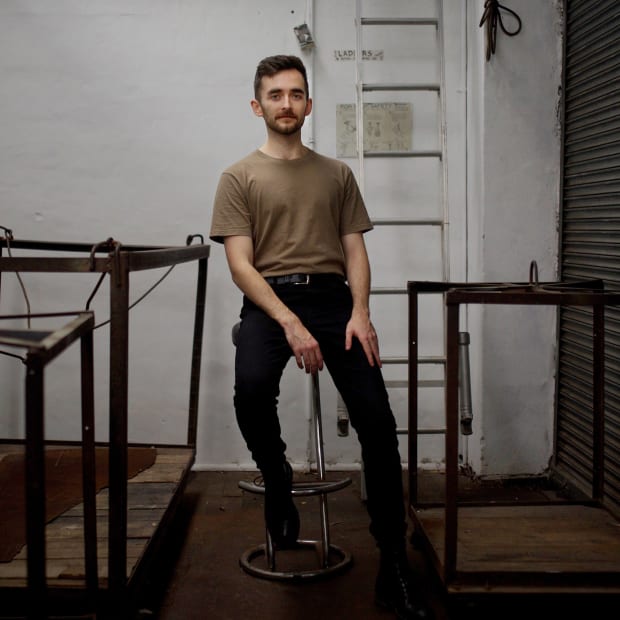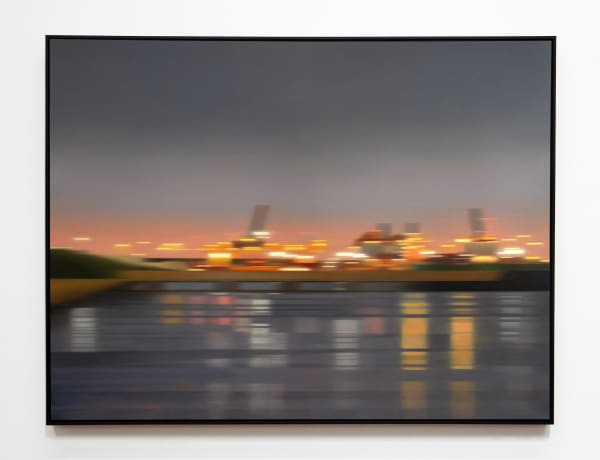
N.Smith Gallery is delighted to present Sunrise, Sunset – a group exhibition celebrating the gallery's third birthday by bringing together fourteen of the gallery's represented artists thematically.
We warmly invite you to view Sunrise, Sunset in our new gallery space at 15 Foster Street, Surry Hills until 8 June.
Opening celebration
Thursday 30 May 6-8pm

Holly Anderson's painting practice investigates sensory experiences between light and landscape. Hovering between the figurative and the abstract, raw brush strokes fragment into larger monochromatic compositions, building surfaces whose surprising flatness and geometry heightens the strangeness of their persistent realism.
Sunlight permeates an array of Holly's subject matter, with bright bursts of white negative space disrupting the order of gridded geometric surfaces. These painterly grids of stripes and squares produce complex systems that bend or scatter where bright light flashes. Familiar subjects now appear in new light, composed behind the glare of a white hot sun and developing a new visual language for the brilliance of sunlight in the Australian landscape.



'Most of the work I do starts with drawing,' says the artist about his wide-ranging practice. The drawings are then fragmented and redrawn, and the new compositions incorporated into cyanotypes, hand-etched de-silvered mirrors, mobiles and installations. 'There's a balance between concept and formalism, and where those two meet,' explains Tom.
Tom has exhibited in Australia, Japan and Italy, and has undertaken residencies with Perth Institute of Contemporary Arts (PICA), Museo de Arte Moderno Chiloé (MAM), Fremantle Arts Centre (FAC), North Metro TAFE, Sapporo Tenjinyama Art Studio, and Parramatta Artists’ Studios. He was a 2013 recipient of a Clitheroe Foundation Mentorship.


Joshua Charadia's work casts an aesthetic and critical eye on the complex forms of Australia’s industrial landscape. He explores the nature of perception and awareness by drawing close attention to these ubiquitous yet overlooked scenes. Working with the slow mediums of oil paint and charcoal, Charadia affords time to these images, usually seen in passing or from a distance.
Charadia won the Adelaide Perry Prize for Drawing in 2023, and has been a finalist in numerous art prizes, including the Jacaranda Drawing Award (2022), Sulman Prize (2020) and Dobell Drawing Prize (2021, 2019). In 2021 he was awarded the Fisher's Ghost Art Award South West Sydney Award, in 2020 he was awarded People’s Choice at the Adelaide Perry Prize, and in 2018 won 2nd place at the Belle ArtStart Prize. His works are held in the National Art School collection and private collections in Australia, New Zealand, The United Kingdom, & USA.



Working as a collaborative duo since 2001, Claire Healy & Sean Cordeiro’s practice combines a playful sense of humour and an engagement with art historical precedents. The duo's work is characterised by the deconstruction and reinvention of prefabricated structures and objects into extraordinary sculptures and installations. Readymade materials often feature in their work, including Lego, Ikea furniture, car and aircraft parts, dinosaur bones, and reconfigured architectural structures.
Claire & Sean won the Sulman Prize in 2022, and have had numerous survey exhibitions in Australia and internationally. The duo’s installation Life Span was included in Australia’s representation at the 53rd Venice Biennale, and the duo have been included in the Auckland Triennial (2013), the Australian Biennial of Art (2018), and Oku-Noto Triennale, Japan (2021). Major solo exhibitions include Post-Haste (2021-22), Blue Mountains Cultural Centre; Claire Healy and Sean Cordeiro (2012-13), Museum of Contemporary Art, Sydney; Are we there Yet? (2011), Corcoran Gallery, Washington DC; The Paper Trail (2007), Art Gallery of New South Wales; and flatpack (2006) Künstlerhaus Bethanien, Berlin.
Request available works / Join Claire & Sean's preview list.


Danie Mellor is a contemporary artist living and working in Bowral, New South Wales. His multidisciplinary research and practice explore intersections between contemporary and historic culture, and the legacies of cultural memory and knowledge. Born in Mackay, North Queensland, his maternal Aboriginal heritage is Ngadjon/Mamu with Scottish and Irish settler ancestry from the Atherton Tablelands and Cairns region, and his father’s family emigrated to Australia from California in the early 1900s.
Mellor’s work is held in multiple regional, all state and significant national collections in Australia, including the National Gallery of Australia and MCA Collection; and in international museums including the National Gallery of Canada, the British Museum, and the National Museums of Scotland. His work has received major awards, acquisitions, and commissions including the MCA Australia’s Sculpture Commission in 2019, the National Gallery of Australia Member’s 2019 Acquisition Fund, and the National Aboriginal and Torres Strait Islander Art Award in 2009. He was awarded his PhD from the Australian National University in 2005 and held positions of lecturer and senior lecturer at the National Institute of the Arts, ANU and then Sydney College of the Arts, University of Sydney.

Dylan Mooney is a proud Yuwi, Torres Strait and South Sea Islander man from Mackay in North Queensland working across painting, printmaking, digital illustration and drawing. Influenced by history, culture and family, Mooney responds to community stories, current affairs and social media. Armed with a rich cultural upbringing, Mooney now translates the knowledge and stories passed down to him through art. Legally blind, the digital medium’s backlit display allows the artist to produce a high-impact illustrative style with bright, saturated colour that reflects his experiences with keen political energy and insight.
Dylan is among artists who are rethinking digital technologies and artistic practices to consider contemporary issues around identity, desire and representation. Interested in the ways in which we can reframe the conversation around some of the voices that have been left out, the artist has made an important body of work that embodies a shift in representation of queer love among people of colour.
Dylan Mooney won the Brisbane Portrait Prize in 2023, and became a member of the board of Museums of History NSW in 2022.


Thea Anamara Perkins is an Arrernte and Kalkadoon artist whose practice incorporates portraiture and landscape to question representations of First Nations peoples and Country. With a delicate hand, Thea answers heavy questions about what it means to be First Nations in contemporary Australia, and interrogates portrayal.
Thea’s middle name Anamara is an Arrernte word that describes a river and a Dreaming that runs north of Mparntwe (Alice Springs) – the place that keeps calling her back and has been the wellspring of art and activism for her family, and by extension, the nation. Perkins continues her family’s commitment to what she calls “strong and ready communication” and is part of an extraordinary dynasty of First Nations activists and creatives that includes activist Charles Perkins (her grandfather), Arrernte elder Hetti Perkins (her great-grandmother), curator Hetti Perkins (her mother) and acclaimed film director Rachel Perkins (her aunt).
Raised and based in Sydney, Thea has family ties to the Redfern community and has worked in a broad range of community projects. Thea was the recipient of the 2023 La Prairie Art Award, administered by The Art Gallery of NSW, and won the Brett Whiteley Travelling Art Scholarship in 2021, and the Alice Prize & Dreaming Award in 2020.





Bold and experimental, Joan Ross' practice investigates the legacy of colonialism in Australia with a particular focus on reconfiguring the colonial Australian landscape and drawing attention to the complex and ongoing issues surrounding the effects of globalisation and colonisation.
Joan's use of fluorescent yellow and high-visibility clothing symbolises colonisation and fear. The act of depicting people in this bright clothing and placing fluorescent objects in the landscape does more, however, than simply illustrate colonisation; it also highlights and exaggerates the foreign or alien aspects of her work and its association with the landscape and the cultural and spiritual connection to place.
Recent projects include designing the hoarding for The Art Gallery of New South Wales' Sydney Modern expansion, and illuminating the façade of The National Gallery of Australia during the 2021 Enlighten Festival. Joan was awarded the National Art School Fellowship in 2023.



A regular finalist in major art prizes, Sally won the People's Choice Award at the 2021 Telstra National Aboriginal and Torres Strait Islander Art Awards (NATSIAA) at the Museum and Art Gallery of the Northern Territory, and the Roberts Family Aboriginal and Torres Strait Islander Prize at the Art Gallery of New South Wales in 2022. The British Broadcasting Corporation (BBC) named Sally as one of the 100 women of the year in 2022, and is a member of the National Gallery of Australia Council and Chair of its First Nations Advisory Group.



Vipoo has exhibited extensively around the world, including Museum of Fine Arts, Boston; Saatchi Gallery, London; Ayala Museum, Philippines; Yingge Ceramics Museum, Taiwan; Nanjing Arts Institute, China and the National Gallery of Thailand. His work is held in national and international public collections across the globe including Henan Museum, China; Roopanakar Museum of Fine Arts, India; Craft Council, UK, and the National Gallery of Australia. In 2021, Vipoo was awarded the Ceramic Artist of the Year by the American Ceramic Society for his contribution to the global clay community.


Walsh has been a recipient of multiple awards, prizes, and scholarships, including The Brett Whiteley Travelling Art Scholarship, Mosman Art Prize, and The Kilgour Prize, and has been a finalist in The Archibald Prize four times, The BP Portrait Award (London National Portrait Gallery), The Royal Scottish Academy Annual Exhibition (Edinburgh), and The Royal Academy of Arts Summer Exhibition (London).


Zhang's work is inspired by horror cinema, Chinese mythology and botany, adopting and placing symbols and motifs in compositions of harmonic dissonance. Her practice explores Chinese mythology – paintings, sculptures and scroll-like banners that incorporate demons, dismembered body parts and organs drawn from anatomy books – overlaid with illustrations of flowers, bones, scholar rocks and auspicious imagery presented in a sugary palette. The aim is to create a visual cacophony, a disjointed and disorientating mash-up of symbols and imagery in an attempt to in part reconcile and make sense of the fissures and contradictions that define her own identity.



* denotes required fields
We will process the personal data you have supplied in accordance with our privacy policy (available on request). You can unsubscribe or change your preferences at any time by clicking the link in our emails.
We won't send you lots of emails. Promise.
* denotes required fields
We will process the personal data you have supplied in accordance with our privacy policy (available on request). You can unsubscribe or change your preferences at any time by clicking the link in our emails.